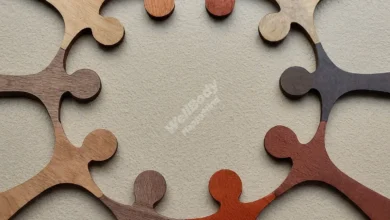Community Wellness Wheel: Balancing Your Social Life

Introduction
Have you ever felt like your social life could use a tune-up? Enter the Community Wellness Wheel – your guide to a more balanced and fulfilling social life. This powerful tool can help you boost your overall well-being by focusing on the social aspects of your life.
In this post, we’ll explore:
- What the Community Wellness Wheel is and why it matters
- Key areas that make up community wellness
- How to assess and improve your own community involvement
- Practical strategies to create a more balanced social life
Are you ready to give your social life a spin? Let’s dive in and discover how the Community Wellness Wheel can transform your community connections and personal happiness!
Understanding the Community Wellness Wheel
What is the Community Wellness Wheel?
The Community Wellness Wheel is a visual tool that helps you assess and balance different aspects of your social life and community involvement. Think of it as a compass for your social well-being, pointing you towards areas that need attention.
Why Does It Matter?
A balanced social life is crucial for your overall health and happiness. When you’re actively engaged in your community, you’re more likely to:
- Feel a sense of belonging
- Have stronger support networks
- Experience improved mental health
- Contribute to positive change around you
Components of the Community Wellness Wheel
The Community Wellness Wheel typically includes 6-8 key areas:
- Social Connections
- Civic Engagement
- Cultural Diversity and Inclusion
- Environmental Stewardship
- Community Resources and Support
- Collective Health and Safety
Each of these areas plays a vital role in creating a thriving community and enhancing your personal well-being.
How It Differs from Individual Wellness Wheels
While individual wellness wheels focus on personal health aspects like physical fitness or emotional well-being, the Community Wellness Wheel zooms out to look at your place within the larger social fabric. It encourages you to think beyond yourself and consider how you interact with and contribute to your community.

Key Areas of Community Wellness
Let’s spin through each section of the Community Wellness Wheel to understand how they contribute to a balanced social life.
Social Connections
Building and maintaining relationships is the cornerstone of community wellness. Strong social connections can boost your mental health, increase your sense of belonging, and even improve your physical well-being.
Tips for fostering meaningful connections:
- Join local clubs or groups based on your interests
- Volunteer for community events or organizations
- Attend neighborhood gatherings or block parties
- Use social media to stay in touch with local friends and events
- Initiate regular catch-ups with neighbors or community members
Civic Engagement
Civic participation means actively taking part in the life and affairs of your community. This can range from voting in local elections to participating in town hall meetings.
Benefits of civic engagement:
- Increased sense of empowerment
- Better understanding of local issues
- Opportunity to shape your community’s future
- Development of leadership skills
- Stronger connection to your neighborhood
Cultural Diversity and Inclusion
Celebrating diversity in your community enriches everyone’s experience and fosters a more welcoming environment. Embracing different cultures, backgrounds, and perspectives leads to a more vibrant and resilient community.
Strategies for promoting inclusivity:
- Attend cultural festivals and events in your area
- Support local businesses owned by diverse community members
- Learn about the history and traditions of different cultures in your community
- Advocate for inclusive policies in local organizations and government
- Encourage diverse representation in community leadership roles

Environmental Stewardship
The health of your community is closely tied to the health of its environment. Taking care of your local ecosystem not only improves the physical space around you but also fosters a sense of shared responsibility.
Simple ways to contribute to environmental health:
- Participate in local clean-up events
- Start or join a community garden
- Advocate for green spaces in your neighborhood
- Use eco-friendly transportation options when possible
- Educate others about local environmental issues
Community Resources and Support
Every community has a network of resources and support systems. Knowing what’s available and how to access these services can greatly enhance your quality of life and help you support others.
To access and utilize community services:
- Research local government websites for available programs
- Visit your local library for information on community resources
- Attend community fairs or expos showcasing local services
- Connect with social workers or community liaisons for guidance
- Share information about helpful resources with your neighbors
Collective Health and Safety
Public health initiatives and community safety programs play a crucial role in maintaining the overall well-being of your neighborhood.
Community health and safety measures:
- Neighborhood watch programs
- Local health clinics and vaccination drives
- Emergency preparedness plans
- Community fitness programs
- Mental health awareness campaigns
Assessing Your Community Wellness
Before you can start balancing your Community Wellness Wheel, it’s important to understand where you currently stand. Let’s explore how to evaluate your community involvement and set goals for improvement.
Self-Reflection Questions
Take a moment to consider these questions:
- How often do I interact with my neighbors?
- Have I participated in any local events in the past month?
- Do I know about the different cultures represented in my community?
- What local environmental initiatives am I aware of?
- Can I name three community resources available to me?
- How do I contribute to the health and safety of my neighborhood?
Your answers will help you identify areas of strength and opportunities for growth in your community engagement.
Tips for Identifying Areas of Improvement
- Keep a community engagement journal for a week, noting all interactions and activities related to your local area.
- Talk to active community members about their involvement and what they find rewarding.
- Attend a local council meeting to learn about current issues and initiatives.
- Review local news sources to stay informed about community happenings.
- Take a walk around your neighborhood with fresh eyes, looking for ways you could contribute.
Setting Realistic Goals for Community Involvement
Start small and build up gradually. Here’s a step-by-step guide:
- Choose one area of the Community Wellness Wheel to focus on first.
- Set a specific, measurable goal for the next month (e.g., attend two community events).
- Break your goal down into actionable weekly steps.
- Track your progress and celebrate small victories.
- Reassess and adjust your goals as needed after the first month.

Strategies for Spinning Your Community Wellness Wheel
Now that you’ve assessed your current situation, let’s look at how to create balance and overcome common obstacles.
Balancing Different Areas of Community Wellness
- Prioritize areas that need the most attention based on your self-assessment.
- Look for activities that overlap multiple areas of the wellness wheel.
- Rotate your focus each month to ensure you’re touching on all aspects of community wellness.
- Partner with friends or family to engage in different areas together.
- Reflect regularly on how your efforts in one area might be impacting others.
Overcoming Common Obstacles to Participation
- Time constraints: Start with small, manageable commitments.
- Feeling overwhelmed: Break larger goals into smaller, actionable steps.
- Lack of information: Reach out to local organizations or use online resources to learn more.
- Social anxiety: Begin with online community forums before moving to in-person events.
- Financial limitations: Look for free community events or low-cost ways to contribute.
Creating a Personal Action Plan
- Identify your ‘why’: Clarify your motivation for increasing community involvement.
- Set SMART goals: Specific, Measurable, Achievable, Relevant, and Time-bound.
- Create a schedule: Block out time for community activities in your calendar.
- Build a support network: Connect with like-minded individuals for accountability.
- Plan for obstacles: Anticipate challenges and brainstorm solutions in advance.
- Track and celebrate progress: Keep a log of your community engagement and reward yourself for milestones.
By following these strategies, you’ll be well on your way to spinning a more balanced Community Wellness Wheel. Remember, the goal is progress, not perfection. Every small step you take contributes to a stronger, more connected community.
The Ripple Effect: How Individual Actions Impact Community Wellness
Your actions, no matter how small, can create waves of positive change in your community. Let’s explore this powerful concept.
Examples of Small Actions with Big Impacts
- Picking up litter in your neighborhood can inspire others to do the same, leading to a cleaner environment.
- Checking on an elderly neighbor might encourage a culture of care and support in your community.
- Supporting a local business can boost the local economy and preserve community character.
- Volunteering at a local event can inspire others to get involved, increasing overall civic engagement.
Inspiring Story of Community Change
Consider the story of Sarah, a resident of Millbrook, who noticed a lack of green spaces in her neighborhood. She started by planting flowers in her front yard, which caught the attention of her neighbors. Soon, she organized a community gardening group. Within a year, their efforts transformed several vacant lots into vibrant community gardens, increasing property values and fostering stronger community bonds.

Technology and Community Wellness
In our digital age, technology plays a crucial role in community engagement. Let’s examine how to leverage it effectively.
Digital Tools for Community Engagement
- Neighborhood apps like Nextdoor for local communications
- Online volunteering platforms to find opportunities
- Local government websites for updates and resources
- Social media groups focused on community issues
- Digital town halls for participating in local decision-making
Balancing Online and Offline Community Participation
While digital tools are valuable, it’s essential to maintain face-to-face connections. Here’s how to strike a balance:
- Use online platforms to organize offline meetups
- Attend in-person events you discover through digital channels
- Share real-world community experiences on social media to inspire others
- Limit screen time to ensure you’re physically present in your community
Potential Pitfalls and How to Avoid Them
- Information overload: Curate your digital feeds to focus on key community issues.
- Echo chambers: Seek diverse perspectives both online and offline.
- Neglecting real-world interactions: Set goals for in-person community engagement.
- Privacy concerns: Be mindful of the information you share online about community activities.
Maintaining Momentum: Long-term Community Wellness
Sustaining your community involvement over time is key to spinning a well-balanced Community Wellness Wheel.
Setting Sustainable Habits
- Start small and gradually increase your involvement
- Integrate community activities into your regular routine
- Find a community “buddy” for mutual support and accountability
- Rotate your areas of focus to prevent burnout
- Celebrate your achievements, no matter how small
Reevaluating and Adjusting Your Community Wellness Wheel
- Schedule regular check-ins with yourself (e.g., monthly or quarterly)
- Assess your progress in each area of the wellness wheel
- Identify areas that need more attention or new challenges to tackle
- Adjust your goals based on your current circumstances and community needs
- Seek feedback from community members or leaders on your involvement
Encouraging Others to Participate
- Share your positive experiences with friends and neighbors
- Invite others to join you in community activities
- Highlight the benefits you’ve gained from community involvement
- Recognize and appreciate others’ contributions to the community
- Be a mentor for those new to community engagement

Conclusion
Spinning your Community Wellness Wheel towards a balanced social life is a journey, not a destination. By focusing on key areas like social connections, civic engagement, and environmental stewardship, you can create a ripple effect of positive change in your community.
Remember, every action counts. Whether it’s attending a local event, volunteering, or simply getting to know your neighbors better, you’re contributing to a stronger, more vibrant community.
As you move forward, leverage technology wisely, maintain a balance between online and offline engagement, and set sustainable habits. Regularly reassess your Community Wellness Wheel and adjust your efforts as needed.
Your journey towards community wellness starts now. What small step will you take today to start spinning your wheel? Share your plans or experiences in the comments below, and let’s inspire each other to create thriving, connected communities!
Additional Resources
To further support your community wellness journey, consider exploring:
- Local community organizations (research options in your area)
- Books on community engagement:
- “Better Together” by Robert D. Putnam
- “The Art of Community” by Charles Vogl
For more articles on personal and community well-being, don’t forget to explore other posts on wellbodyhappymind.com. Together, we can create healthier, happier communities one spin at a time!



